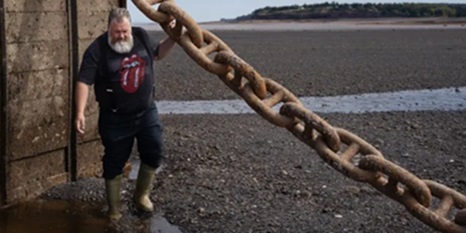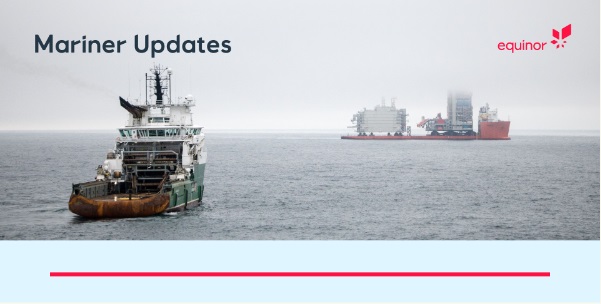Search Results for: Orin C

Bad hull, flooding led to fatal sinking of Orin C
The deadly sinking of the Gloucester-ported Orin C nearly 15 months ago probably was caused by structural problems with the vessel’s wooden hull and subsequent flooding, according to reports from the National Transportation Safety Board and Coast Guard released Thursday. The two reports detailed the marine tragedy that resulted in the drowning of 47-year-old Capt. David C. “Heavy D” Sutherland during the final stages of the Coast Guard’s rescue that saved crewmembers Rick Palmer and Travis Lane on the night of Dec. 3, 2015. Neither Palmer nor Lane could be reached Thursday for comment. The Coast Guard report did not recommend any changes to its training, rescue procedures or the equipping of its rescue vessels. That, however, does not mean it won’t make changes in the future, according to District 1 Deputy Commander Brad Kelly. “That is something the Coast Guard is always looking at in trying to determine what should be included into all of our rescue platforms,” Kelly said. “That is an ongoing process.” Continue reading the article here 21:01

As anniversary nears, reports on deadly F/V Orin C sinking unfinished
Saturday will mark the one-year anniversary of the sinking of the Orin C and the death of Gloucester fisherman David “Heavy D” Sutherland, but the final federal reports on the deadly incident still will not be released until January. Representatives of the Coast Guard and the National Transportation Safety Board on Monday confirmed the new timetable for releasing the findings of the separate investigations and restated the government’s intention to release the reports simultaneously. “We were really pushing to have a completed report before the anniversary of the tragedy to help bring some closure up here,” said Lt. Karen Kutiewicz of the Coast Guard’s District 1 Headquarters in Boston. “That was our goal. Unfortunately, it’s not the reality.”The draft of the Coast Guard’s internal casualty investigation was completed earlier this year and forwarded during the summer to Washington, D.C., for review by officials at Coast Guard headquarters. In July, the NTSB said it expected to release the conclusions of its investigation “sometime in the fall.” An NTSB spokesman on Monday said the agency has not yet concluded its investigation and does not expect to have the final report until mid-January. Read the story here 09:01
Coast Guard completes F/V Orin C investigation – Draft report of rescue under review
 The U.S. Coast Guard is getting closer to finalizing its casualty investigation into December’s sinking of the Orin C and the drowning death of owner and Captain David “Heavy D” Sutherland during the rescue attempt that saved two crew members. A draft of the Coast Guard’s internal investigation has been completed at the Coast Guard’s District 1 Headquarters in Boston and now is under review at Coast Guard headquarters in Washington D.C., according to Lt. Karen Kutkiewicz, a public affairs officer for the service. “I have no definite timeline on when (the Coast Guard) will publish the final findings, nor where they are in the review process,” Kutkiewicz said in an email response to the Gloucester Daily Times. “The findings will be made public once finalized by Coast Guard headquarters.” The National Transportation Safety Board also is investigating the sinking of the Orin C on Dec. 3, 2015, about 12 miles off Thacher Island. The incapacitated 51-foot slime-eel fishing boat was being towed back to Gloucester Harbor through worsening seas, first by a Good Samaritan fisherman and later by the Coast Guard. Read the rest here 09:46
The U.S. Coast Guard is getting closer to finalizing its casualty investigation into December’s sinking of the Orin C and the drowning death of owner and Captain David “Heavy D” Sutherland during the rescue attempt that saved two crew members. A draft of the Coast Guard’s internal investigation has been completed at the Coast Guard’s District 1 Headquarters in Boston and now is under review at Coast Guard headquarters in Washington D.C., according to Lt. Karen Kutkiewicz, a public affairs officer for the service. “I have no definite timeline on when (the Coast Guard) will publish the final findings, nor where they are in the review process,” Kutkiewicz said in an email response to the Gloucester Daily Times. “The findings will be made public once finalized by Coast Guard headquarters.” The National Transportation Safety Board also is investigating the sinking of the Orin C on Dec. 3, 2015, about 12 miles off Thacher Island. The incapacitated 51-foot slime-eel fishing boat was being towed back to Gloucester Harbor through worsening seas, first by a Good Samaritan fisherman and later by the Coast Guard. Read the rest here 09:46
NTSB: No plans to salvage Fishing Vessel Orin C
 The National Transportation Safety Board confirmed today it will lead the investigation into last week’s sinking of the Orin C that cost the life of a Gloucester fisherman, but the agency has no plans to salvage the 51-foot vessel from the bottom of the Atlantic Ocean. Keith Holloway, an NTSB spokesman, said the investigation could take as long as 12 to 18 months to determine the probable cause of the Dec. 3 sinking that took the life of 47-year-old Gloucester fisherman David “Heavy D” Sutherland. “Information will be released as it becomes available,”,, Read the article here 12:05
The National Transportation Safety Board confirmed today it will lead the investigation into last week’s sinking of the Orin C that cost the life of a Gloucester fisherman, but the agency has no plans to salvage the 51-foot vessel from the bottom of the Atlantic Ocean. Keith Holloway, an NTSB spokesman, said the investigation could take as long as 12 to 18 months to determine the probable cause of the Dec. 3 sinking that took the life of 47-year-old Gloucester fisherman David “Heavy D” Sutherland. “Information will be released as it becomes available,”,, Read the article here 12:05
One Fisherman is dead, two are rescued after Gloucester fishing vessel Orin C sinks
 The Coast Guard rescued two fishermen and recovered a third deceased Thursday after their fishing boat sank 12 miles off Thatcher Island, Gloucester. A good Samaritan aboard the Foxy Lady notified watchstanders at the Coast Guard Sector Boston command center at about 3 p.m. that the fishing boat Orin C was disabled and needed a tow. The Foxy Lady began towing Orin C toward shore, but high wind and waves impeded their effort. A large wave reportedly crashed over Orin C’s bow, causing the boat to flood. Read the rest here 08:45
The Coast Guard rescued two fishermen and recovered a third deceased Thursday after their fishing boat sank 12 miles off Thatcher Island, Gloucester. A good Samaritan aboard the Foxy Lady notified watchstanders at the Coast Guard Sector Boston command center at about 3 p.m. that the fishing boat Orin C was disabled and needed a tow. The Foxy Lady began towing Orin C toward shore, but high wind and waves impeded their effort. A large wave reportedly crashed over Orin C’s bow, causing the boat to flood. Read the rest here 08:45
The Orin C at the Gloucester Railways in Rocky Neck.
A good portion of her keel was torn off earlier this week when she struck the rocks by Ten Pound island. Un-confirmed reports has it that vessel operator Dave (Heavy D.) Southerland was leaving the harbor on auto-pilot and left the wheel for a moment when an error caused the vessel to stray from the channel. There was some mild propeller damage that may or may not have been caused during the incident. 12:54:13
Exploring the impact of offshore wind on whale deaths
 In the winter of 2022–2023, nearly a dozen whales died off the coast of New Jersey, near the sites of several proposed wind farms. Their deaths prompted concern that related survey work being conducted in the area somehow contributed to their deaths. The increased presence of these turbines in coastal waters, along with the noise from construction and surveys, has led to concerns of their impact on marine life. In particular, cetaceans such as whales and dolphins are likely to be sensitive to the noises and increased marine traffic brought by these turbines. However, the Marine Mammal Commission, a federal oversight agency, states there is no evidence linking the whales that died in the New Jersey region in the winter of 2022–2023 to wind energy development. more, >>CLICK TO READ<< 10:35
In the winter of 2022–2023, nearly a dozen whales died off the coast of New Jersey, near the sites of several proposed wind farms. Their deaths prompted concern that related survey work being conducted in the area somehow contributed to their deaths. The increased presence of these turbines in coastal waters, along with the noise from construction and surveys, has led to concerns of their impact on marine life. In particular, cetaceans such as whales and dolphins are likely to be sensitive to the noises and increased marine traffic brought by these turbines. However, the Marine Mammal Commission, a federal oversight agency, states there is no evidence linking the whales that died in the New Jersey region in the winter of 2022–2023 to wind energy development. more, >>CLICK TO READ<< 10:35
UK Government Launches Remote Electronic Monitoring on Fishing Vessels
 The UK Government has begun rolling out Remote Electronic Monitoring (REM) systems on fishing vessels, marking a significant step towards modernising the monitoring of fishing activities and promoting sustainability. The Department for Environment, Food and Rural Affairs (Defra), in collaboration with key partners, is implementing this technology to collect real-time data on fishing activities and catches, supporting both the industry and environmental conservation efforts. The REM system, comprising sensors and cameras, will provide data on the location and timing of fishing operations and what species are being caught. Defra’s Fisheries Act (2020) and the Joint Fisheries Statement form the legal basis for this initiative, aimed at ensuring a sustainable future for UK fisheries. more, >>CLICK TO READ<< 11:47
The UK Government has begun rolling out Remote Electronic Monitoring (REM) systems on fishing vessels, marking a significant step towards modernising the monitoring of fishing activities and promoting sustainability. The Department for Environment, Food and Rural Affairs (Defra), in collaboration with key partners, is implementing this technology to collect real-time data on fishing activities and catches, supporting both the industry and environmental conservation efforts. The REM system, comprising sensors and cameras, will provide data on the location and timing of fishing operations and what species are being caught. Defra’s Fisheries Act (2020) and the Joint Fisheries Statement form the legal basis for this initiative, aimed at ensuring a sustainable future for UK fisheries. more, >>CLICK TO READ<< 11:47
Federal fishing monitoring program needs overhaul, GAO says
 Only days after the Supreme Court dealt a blow to the federal government’s program placing human observers on commercial fishing boats, a federal watchdog said NOAA Fisheries should do a better job monitoring the industry. A report released Wednesday by the Government Accountability Office said NOAA Fisheries — also known as the National Marine Fisheries Service — has failed to execute its program as Congress intended under law. “NMFS’ efforts to track its performance in reducing and monitoring bycatch do not align with key elements of evidence-based policymaking related to performance management,” GAO said in the report, which was requested by Rep. Raúl Grijalva (D-Ariz.), the ranking member of the House Natural Resources Committee. more, >>CLICK TO READ<< 19:19
Only days after the Supreme Court dealt a blow to the federal government’s program placing human observers on commercial fishing boats, a federal watchdog said NOAA Fisheries should do a better job monitoring the industry. A report released Wednesday by the Government Accountability Office said NOAA Fisheries — also known as the National Marine Fisheries Service — has failed to execute its program as Congress intended under law. “NMFS’ efforts to track its performance in reducing and monitoring bycatch do not align with key elements of evidence-based policymaking related to performance management,” GAO said in the report, which was requested by Rep. Raúl Grijalva (D-Ariz.), the ranking member of the House Natural Resources Committee. more, >>CLICK TO READ<< 19:19
Gulf of Alaska trawl pollock vessels to be included in electronic monitoring program
 According to the 2023 annual report from the North Pacific Observer Program, the vast majority of groundfish harvest in Alaska is observed with full coverage, meaning 100% of all trips are monitored by either onboard observers or electronic monitoring. After years of testing the program, electronic monitoring will soon be expanded to include pelagic trawl pollock catcher vessels and tenders delivering to shoreside processors or stationary floating processors, across the Bering Sea and Aleutian Islands, and the Gulf of Alaska. That includes vessels that already have an observer on board. more, >>CLICK TO READ<< 07:55
According to the 2023 annual report from the North Pacific Observer Program, the vast majority of groundfish harvest in Alaska is observed with full coverage, meaning 100% of all trips are monitored by either onboard observers or electronic monitoring. After years of testing the program, electronic monitoring will soon be expanded to include pelagic trawl pollock catcher vessels and tenders delivering to shoreside processors or stationary floating processors, across the Bering Sea and Aleutian Islands, and the Gulf of Alaska. That includes vessels that already have an observer on board. more, >>CLICK TO READ<< 07:55
Anchoring the Family: The Life, Labor and Love of an Alaskan Fishing Mom
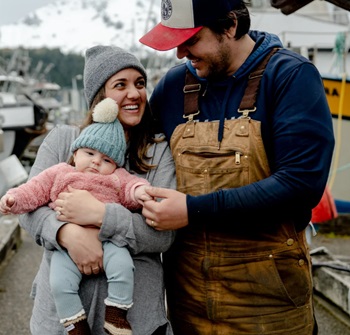 It’s called a labor of love for a reason. A life in fishing – especially in Alaska – can be equally rough and rewarding, spending days at sea where the wonders of the world take shape in glacial ridges and splashes of fish slipping over each other on deck. What you don’t always see is the effort, will, patience and passion of the people caring for those on the water from behind the shoreline. On the rugged coast of southern Alaska, where icy waters provide hope for a rich season, Kinsey Brown and her husband, Zeke, have woven their lives into the fabric of their small fishing community. It’s been said countless times by dedicated seafood harvesters across the globe that fishing is more than a livelihood. It’s a calling, community and a legacy that nearly all who fish hope to pass down to the newest generations of their fishing families. Video, photos, more, >>CLICK TO READ<< 10:30
It’s called a labor of love for a reason. A life in fishing – especially in Alaska – can be equally rough and rewarding, spending days at sea where the wonders of the world take shape in glacial ridges and splashes of fish slipping over each other on deck. What you don’t always see is the effort, will, patience and passion of the people caring for those on the water from behind the shoreline. On the rugged coast of southern Alaska, where icy waters provide hope for a rich season, Kinsey Brown and her husband, Zeke, have woven their lives into the fabric of their small fishing community. It’s been said countless times by dedicated seafood harvesters across the globe that fishing is more than a livelihood. It’s a calling, community and a legacy that nearly all who fish hope to pass down to the newest generations of their fishing families. Video, photos, more, >>CLICK TO READ<< 10:30
Pair of bills makes electronic monitoring of state-regulated fisheries a possibility
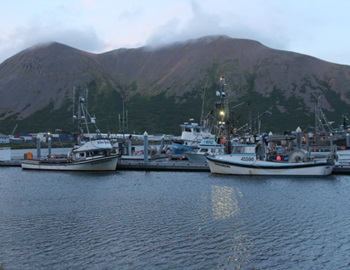 Nels Evens is a longliner and gillnetter, and the executive director of the Petersburg Vessel Owners Association. He says he’s not sure what the bills’ aim is. “Because it is so broad, and we don’t understand what it’s really trying to get at, we’re not supportive of it,” he said. The pair of bills – Senate Bill 209 and House Bill 294 – stem from a discussion at last year’s Board of Fisheries meeting. The Board was trying to figure out how to enforce regulations that require Area M fishermen to keep chum salmon, instead of tossing them back in favor of much more valuable King salmon. Area M is along the Alaska Peninsula and Eastern Aleutians. It intercepts some chum salmon bound for western Alaska. more, >>click to read<< 08:53
Nels Evens is a longliner and gillnetter, and the executive director of the Petersburg Vessel Owners Association. He says he’s not sure what the bills’ aim is. “Because it is so broad, and we don’t understand what it’s really trying to get at, we’re not supportive of it,” he said. The pair of bills – Senate Bill 209 and House Bill 294 – stem from a discussion at last year’s Board of Fisheries meeting. The Board was trying to figure out how to enforce regulations that require Area M fishermen to keep chum salmon, instead of tossing them back in favor of much more valuable King salmon. Area M is along the Alaska Peninsula and Eastern Aleutians. It intercepts some chum salmon bound for western Alaska. more, >>click to read<< 08:53
Maine Lobstermen Ask Court to Block State Agency from Enforcing a 24-Hour Location Monitoring Mandate Pending the Resolution of Their Lawsuit
 A group of Maine lobstermen have asked the United States District Court for the District of Maine to temporarily block state officials from enforcing the controversial requirement that lobstering boats be equipped with a 24-hour location monitoring system. At the beginning of January, five Maine lobstermen filed a lawsuit against the Maine Department of Marine Resources (MDMR) Commissioner Patrick Keliher, alleging violations of their Fourth and Fourteenth Amendment rights. “Before the Court is an unprecedented regulation that, if permitted to stand, would require federally permitted Maine lobster fishermen to install a tracking device on their fishing vessels that would monitor their movements on a minute-by-minute basis (and every six hours when the vessel is moored) ‘regardless of landing state, trip type, location fished or target species,’” the motion reads. more, >>click to read<< 06:44
A group of Maine lobstermen have asked the United States District Court for the District of Maine to temporarily block state officials from enforcing the controversial requirement that lobstering boats be equipped with a 24-hour location monitoring system. At the beginning of January, five Maine lobstermen filed a lawsuit against the Maine Department of Marine Resources (MDMR) Commissioner Patrick Keliher, alleging violations of their Fourth and Fourteenth Amendment rights. “Before the Court is an unprecedented regulation that, if permitted to stand, would require federally permitted Maine lobster fishermen to install a tracking device on their fishing vessels that would monitor their movements on a minute-by-minute basis (and every six hours when the vessel is moored) ‘regardless of landing state, trip type, location fished or target species,’” the motion reads. more, >>click to read<< 06:44
Lobstermen Sue State Agency for Mandating Installation of 24-Hour Electronic Location Monitoring System on Their Boats
 A group of five Maine lobstermen are suing Maine Department of Marine Fisheries (MDMR) Commissioner Patrick Keliher over new rules mandating that all federally permitted lobster boats be equipped with a 24-hour electronic location monitoring system. These mandated devices — provided by the MDMR — identify a vessel’s location every sixty seconds while in motion and once every six hours when stationary. Using one of these devices, a boat’s position is able to be accurately determined within 100 meters, or 328.1 feet. According to the lobstermen, this new requirement violates the Fourth and Fourteenth Amendments, as they allege that it jeopardizes their Constitutionally protected rights to privacy and due process. more, >>click to read<< 11:20
A group of five Maine lobstermen are suing Maine Department of Marine Fisheries (MDMR) Commissioner Patrick Keliher over new rules mandating that all federally permitted lobster boats be equipped with a 24-hour electronic location monitoring system. These mandated devices — provided by the MDMR — identify a vessel’s location every sixty seconds while in motion and once every six hours when stationary. Using one of these devices, a boat’s position is able to be accurately determined within 100 meters, or 328.1 feet. According to the lobstermen, this new requirement violates the Fourth and Fourteenth Amendments, as they allege that it jeopardizes their Constitutionally protected rights to privacy and due process. more, >>click to read<< 11:20
Exploring the viability of large-scale hatchery production of Atlantic surf clams for fishery enhancement
 Fishery stock enhancement strategies – also known as restocking for conservation purposes, or sea ranching for economic purposes – have gained interest among U.S. stakeholders as challenges associated with food security, marine habitat degradation and potential job losses increase due to anthropogenic stressors. The Atlantic surf clam (Spisula solidissima) is considered one of the most important commercial clam species harvested in the United States. It is a large marine bivalve that is distributed from the Gulf of St. Lawrence, Canada to Cape Hatteras, North Carolina; however, the fishery for Atlantic surf clam is based off the Mid-Atlantic coast, where surf clams have historically been most abundant. more, >>click to read<< 13:18
Fishery stock enhancement strategies – also known as restocking for conservation purposes, or sea ranching for economic purposes – have gained interest among U.S. stakeholders as challenges associated with food security, marine habitat degradation and potential job losses increase due to anthropogenic stressors. The Atlantic surf clam (Spisula solidissima) is considered one of the most important commercial clam species harvested in the United States. It is a large marine bivalve that is distributed from the Gulf of St. Lawrence, Canada to Cape Hatteras, North Carolina; however, the fishery for Atlantic surf clam is based off the Mid-Atlantic coast, where surf clams have historically been most abundant. more, >>click to read<< 13:18
Tākaka fisherman who illegally removed monitoring device fined $20k, loses boat
 A fisherman who removed essential position monitoring equipment from his boat and then tried to hide it in a bag beneath the sea has been convicted in a case that is the first of its kind in the country. Tony Peter Phillipson has also had his boat forfeited after breaching rules designed to help monitor and protect New Zealand fisheries. Judge Tony Zohrab said in the Nelson District Court today that little of what Phillipson had done made any sense, but his explanation at the time “smelled like fish left in the hold for a couple of weeks” and was in the realm of “gross dishonesty”. more, >>click to read<< 07:15
A fisherman who removed essential position monitoring equipment from his boat and then tried to hide it in a bag beneath the sea has been convicted in a case that is the first of its kind in the country. Tony Peter Phillipson has also had his boat forfeited after breaching rules designed to help monitor and protect New Zealand fisheries. Judge Tony Zohrab said in the Nelson District Court today that little of what Phillipson had done made any sense, but his explanation at the time “smelled like fish left in the hold for a couple of weeks” and was in the realm of “gross dishonesty”. more, >>click to read<< 07:15
P.E.I. Fishermen’s Association calls for more timely, better monitoring in wake of federal report
 Executive director Ian MacPherson said a recent report from the federal environment commissioner underlined the importance of doing more, and better science, especially as the crucial herring and mackerel fisheries remain closed to Island fishers. “Herring and mackerel are the big ones here on Prince Edward Island, important fisheries to us, and we’d like to get them reopened — and we realize these are science-based decisions, but you need accurate and timely information,” MacPherson said. >>click to read<< 06:38
Executive director Ian MacPherson said a recent report from the federal environment commissioner underlined the importance of doing more, and better science, especially as the crucial herring and mackerel fisheries remain closed to Island fishers. “Herring and mackerel are the big ones here on Prince Edward Island, important fisheries to us, and we’d like to get them reopened — and we realize these are science-based decisions, but you need accurate and timely information,” MacPherson said. >>click to read<< 06:38
New tech designed with Cornish fishermen to transform bycatch monitoring
 An innovative new tool being developed with fishermen in Cornwall aims to radically transform how by-catch is documented on board fishing vessels and, ultimately, prevent it happening. In a UK-first, Insight360 combines voice recognition and video information to deliver real-time insight and create a 360-degree view of what’s happening at sea during a by-catch event, that continuously improves over time. Refined with fishermen, the technology removes the need to manually review and add notes to footage, offering instead a way for skippers and crews to train a monitoring system to automatically recognise and record bycatch events as they happen. >>click to read<< 08:19
An innovative new tool being developed with fishermen in Cornwall aims to radically transform how by-catch is documented on board fishing vessels and, ultimately, prevent it happening. In a UK-first, Insight360 combines voice recognition and video information to deliver real-time insight and create a 360-degree view of what’s happening at sea during a by-catch event, that continuously improves over time. Refined with fishermen, the technology removes the need to manually review and add notes to footage, offering instead a way for skippers and crews to train a monitoring system to automatically recognise and record bycatch events as they happen. >>click to read<< 08:19
Fisheries and Oceans Canada doing a poor job of monitoring fishing industry: report
 A new report slams the federal Fisheries Department for failing to properly monitor Canada’s commercial fishing industry. The report from the federal environment commissioner, Jerry DeMarco, says Fisheries and Oceans Canada lacks the ability to collect timely and dependable data about what is being caught. DeMarco says the dearth of reliable data means the department can’t protect Canada’s fish stocks from overfishing. The report from the federal environment commissioner, Jerry DeMarco, says Fisheries and Oceans Canada lacks the ability to collect timely and dependable data about what is being caught.>>click to read<< 13:02
A new report slams the federal Fisheries Department for failing to properly monitor Canada’s commercial fishing industry. The report from the federal environment commissioner, Jerry DeMarco, says Fisheries and Oceans Canada lacks the ability to collect timely and dependable data about what is being caught. DeMarco says the dearth of reliable data means the department can’t protect Canada’s fish stocks from overfishing. The report from the federal environment commissioner, Jerry DeMarco, says Fisheries and Oceans Canada lacks the ability to collect timely and dependable data about what is being caught.>>click to read<< 13:02
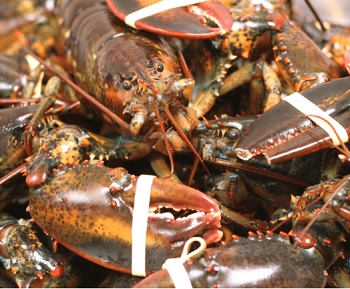
Observer companies dumped from monitoring of N.S. lobster fishery
This season, DFO will rely solely on an inshore industry association to assess what other species are being accidentally captured — what’s known as bycatch — in the lobster fishery from Halifax through the Bay of Fundy. Observer companies Javitech Atlantic in Dartmouth and Halifax’s Atlantic Catch Data have been part of the bycatch monitoring program since it was launched in 2018 to assess and demonstrate sustainability in the fishery worth half a billion dollars. Both companies are out for now. In recent years, they have not delivered anywhere near the sampling provided by the Yarmouth-based Southwest Lobster Science Society, which was created by five fishing associations to provide bycatch monitoring. >>click to read<< 08:30
A reporter went on the Jones Act Enforcer vessel monitoring Vineyard Wind. What she saw.
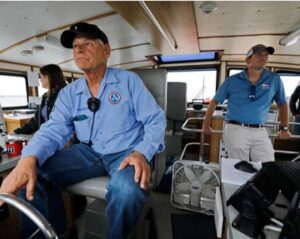 Aaron Smith, president and CEO of the Offshore Marine Service Association, was our host on this trip. It’s his intent on behalf of the association to be on the lookout for ships in violation of the Jones Act and taking jobs away from American workers. The ship is named after the Jones Act, a section of federal law that regulates maritime commerce in the United States by requiring that goods shipped between U.S. points be transported on ships that are built, owned and operated by United States citizens or permanent residents. Captain Rick Spaid and his crew sped through the water at about 17 knots give or take when he was able and brought us within about 0.5 nautical miles of the ships we saw. Photos, >click to read< 09:46
Aaron Smith, president and CEO of the Offshore Marine Service Association, was our host on this trip. It’s his intent on behalf of the association to be on the lookout for ships in violation of the Jones Act and taking jobs away from American workers. The ship is named after the Jones Act, a section of federal law that regulates maritime commerce in the United States by requiring that goods shipped between U.S. points be transported on ships that are built, owned and operated by United States citizens or permanent residents. Captain Rick Spaid and his crew sped through the water at about 17 knots give or take when he was able and brought us within about 0.5 nautical miles of the ships we saw. Photos, >click to read< 09:46
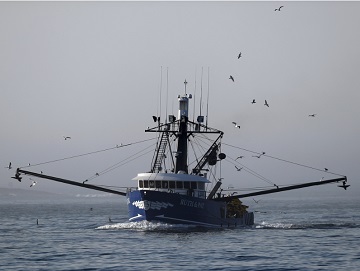
Courts threaten to sink federal fishery monitoring
NOAA suffered a major blow in February when a three-judge panel of the 5th U.S. Circuit Court of Appeals in Louisiana threw out a rule that would have required charter boats in the Gulf of Mexico to be equipped with electronic monitors to report fish catches. Fishermen complained that the devices would cost them as much as $3,000 per boat. And the agency may be poised for an even bigger setback from the Supreme Court. Justices last month said they would take up a case that could decide whether NOAA has the legal authority to force New England herring fishermen to hire third-party contractors to monitor their fishing at a cost of up to $700 per day. >click to read< 13:55

Ignoring dead whales, NOAA proposes another site survey off New Jersey
“Damn the whales, full speed ahead” seems to be the offshore wind policy of Biden’s NOAA. They now propose to approve yet another site survey, just 10 miles off Atlantic City. These surveys are the top suspect for the recent wave of dead whales, centered on New Jersey. The site is a big one because the offshore wind project is huge. Phase 1 is a whopping 1,500 MW, which means over 100 monster turbine towers. The survey area is around 1,500,000 acres or an incredible 2,300 square miles. Ironically the project is called Atlantic Shores, which is where all the dead whales are washing up. More deeply, the Atlantic Shores Wind Project has yet to be approved and may never be. Hugely disruptive site surveys should not be authorized until the Project is approved. >click to read< 13:57

Oregon Fishing Industry Fed Up With Agency ‘Ignoring’ Their Offshore Wind Concerns
The West Coast Seafood Processors Association, the Midwater Trawlers Cooperative and the Oregon Dungeness Crab Commission claim their concerns about proposed offshore wind project call areas, areas where the agency is seeking public comment, and their impact on key fish populations due to the turbines’ electromagnetic field (EMF) cables, have been ignored by BOEM. They also worry about the impact offshore winds would have on their businesses and the entire state’s economy. “BOEM has told us that if Oregon doesn’t want this, they will back off and pursue other offshore wind areas, and we’ve made it pretty clear to them that Oregon doesn’t want this, and they’re still pushing forward,” Lori Steele, executive director of the seafood trade group West Coast Seafood Processors Association, told the DCNF. “They are giving us nothing but lip service,” she added. >click to read< 09:43

New monitoring rules for Northeast fishermen
Changes to U.S. rules about the monitoring of Northeast commercial fishing activities are going into effect this month with a goal of providing more accurate information about some of the nation’s oldest fisheries. The U.S. mandates observers to work onboard fishing boats to collect data and make sure fishermen adhere to rules and quotas. The National Marine Fisheries Service has adopted new monitoring rules for Northeast fishermen of groundfish, like haddock and flounder, to try to improve the accuracy of the data. >click to read< 11:57








